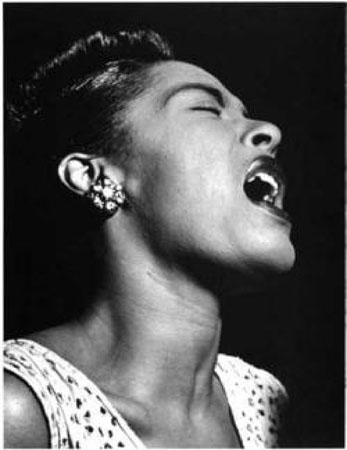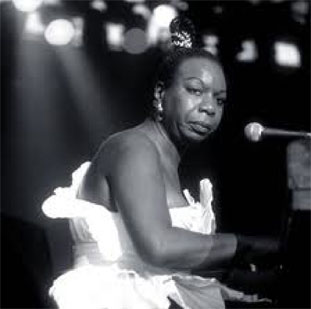MUSIC
Southern trees bear strange fruit,
Blood on the leaves and blood at the root,
Black body swinging in the Southern breeze,
Strange fruit hanging from the poplar trees.
Pastoral scene of the gallant South,
The bulging eyes and the twisted mouth,
Scent of magnolia sweet and fresh,
Then the sudden smell of burning flesh!
Here is fruit for the crows to pluck,
For the rain to gather, for the wind to suck,
For the sun to rot, for the tree to drop,
Here is a strange and bitter crop.
 I had to think twice about including ‘Strange Fruit’ here because its subject matter is so dark, it brought up the question of whether it would fit with JezAlborough.com's positive ethos. However, I decided that this song is positive because of its uncompromising power to confront the listener with such a difficult subject; it is a call from the heart of its writer to question how such atrocities could be allowed to happen. As I’m sure you’ll find, its impact now is as forceful as it must have been when it was first released by Billie Holiday back in 1939.
I had to think twice about including ‘Strange Fruit’ here because its subject matter is so dark, it brought up the question of whether it would fit with JezAlborough.com's positive ethos. However, I decided that this song is positive because of its uncompromising power to confront the listener with such a difficult subject; it is a call from the heart of its writer to question how such atrocities could be allowed to happen. As I’m sure you’ll find, its impact now is as forceful as it must have been when it was first released by Billie Holiday back in 1939.
The poem Strange Fruit was written by Abel Meeropol, a Jewish high-school teacher from the Bronx. It is about the lynching of two black men and is said to be inspired by a photograph taken in Indiana in 1930. He published it in The New York Teacher in 1936 under the pen name Lewis Allan, and later set his poem to music. Together with his wife, who was a singer, Abel performed it as a protest song in Madison Square Garden. Billie Holiday, with whom the song is most famously linked, suggested in her autobiography Lady Sings the Blues that along with her pianist and musical arranger it was she who set the poem to music. When challenged about this claim, Holiday, whose biography had been ghost written, claimed rather humorously ‘I ain’t never read that book!’.
Its rare for a poem to work as lyrics too, in my experience poetry and lyrics are too very different forms of writing. Lyrics work together with music to do their job of connecting with the listener through a story or emotion. If you read lyrics you find that mostly , without the music to back them up, they don’t work so well as pieces of writing. Poetry however has to stand on its own, providing its own rhythm and emotional punch: in a way the words have to work much harder to pull you in. Strange Fruit is a rare case of a poem which works equally well as lyrics.
The song ‘Strange Fruit’ was released in 1939; it became Holiday’s biggest selling record and a staple of her live performances. However, because of its poignancy, some rules were drawn up relating to her performance of it in nightclubs: Holiday would always close with it; the waiters would stop all service in advance; the room would be in darkness except for a spotlight on her face and there would be no encore. I think the reverence and respect shown to this song is testament to its extraordinary power to move people.
 The song went on to bear its own fruit throughout the rest of the twentieth century by inspiring other artists in different fields who created novels, films, operas, poems and plays based on its powerful eloquence. It has also been covered by dozens of singers through the years but for me the most powerful of them is by Nina Simone, who released the song on her album Pastel Blues in 1965. Simone’s haunting performance manages to match the poignancy of the poetry, partly because there is so much space in it. Every mournful descending chord is left hanging as it fades, underscoring the emotions in each devastating line. It is as if Simone has realised that the subject is so strong that each line needs space around it in order for the listener to be able to take it in.
The song went on to bear its own fruit throughout the rest of the twentieth century by inspiring other artists in different fields who created novels, films, operas, poems and plays based on its powerful eloquence. It has also been covered by dozens of singers through the years but for me the most powerful of them is by Nina Simone, who released the song on her album Pastel Blues in 1965. Simone’s haunting performance manages to match the poignancy of the poetry, partly because there is so much space in it. Every mournful descending chord is left hanging as it fades, underscoring the emotions in each devastating line. It is as if Simone has realised that the subject is so strong that each line needs space around it in order for the listener to be able to take it in.
Part of the poem’s power comes from its juxtapositions of images of beauty and horror. Simone reflects this in her voice, at times tender, pained and finally discordant in the climactic final verse where she sings the line ‘for the leaves to drop’. As she freefalls down the scale on the word ‘leaves’ the disharmony it creates is, like the poem itself, quite shocking. It seems like ages before we reach a sense of resolution as the note finally lands, in tune, in a lower octave. Has there ever been a more powerful song sung with such passion and artistry?
NEW ON THE SITE
HAVE YOU SEEN?











